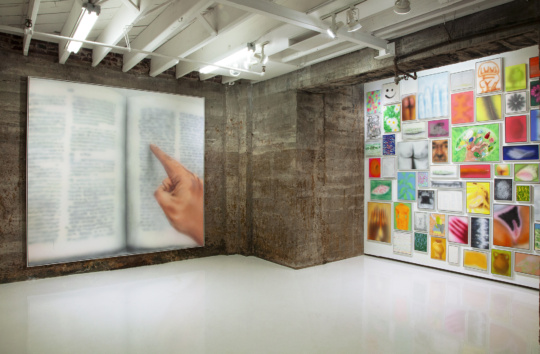Each year on the first Saturday in August, New Orleans celebrates White Linen Night and the opening of open call exhibitions at the Contemporary Arts Center and the Ogden Museum of Southern Art, marking the beginning of the fall cultural season in the city.
At the Contemporary Arts Center, the exhibition Identity Measures (curated by Burnaway contributor Jordan Amirkhani) features works by twenty-one artists or collectives living and working in New Orleans or the surrounding region. At the Ogden, Whitney Museum director of curatorial affairs David Breslin curated Louisiana Contemporary, the latest edition of an annual survey of artists working in the state. As Burnaway previously reported, artist Jessica Strahan received the designation Best in Show and a five thousand dollar prize for her contribution to Louisiana Contemporary.
Charlie Tatum, Burnaway’s New Orleans editor-at-large, and two new contributors, Nic Aziz and Taylor Murrow, report on the stand-out works in this year’s open call exhibitions.
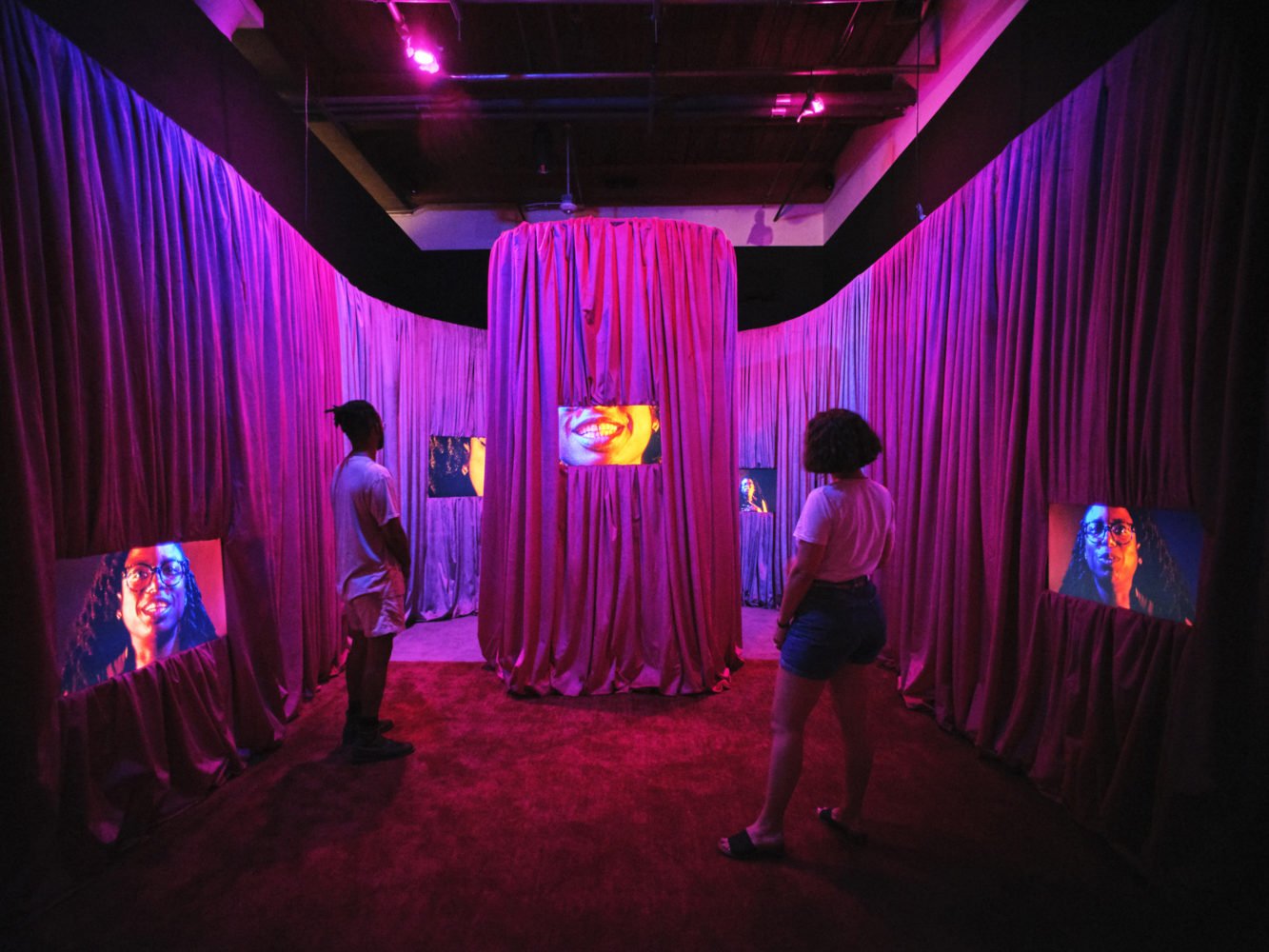
Double Diamond in Identity Measures
In their multi-channel video installation Didn’t Mean it Like That, the artist duo Double Diamond (Ashley Teamer and Marta Rodriguez Maleck) shows interviews with people recounting moments of feeling misunderstood by someone from a different background or with different privileges. The interviews are shown from multiple camera angles, some offering fragmented or close-up views of the speaker’s face and echoing the discomfort that comes with discussing these interactions. Thick, red curtains draped around each monitor create a theatrical element, questioning the roles we each play in our interactions with one another and where the intersections of our identities and prejudices lie. Watching and listening to each person’s stories may cause the viewer to examine their own experiences and question how they might have participated—knowingly or unknowingly—on either side of a similar scenario.
— Taylor Murrow
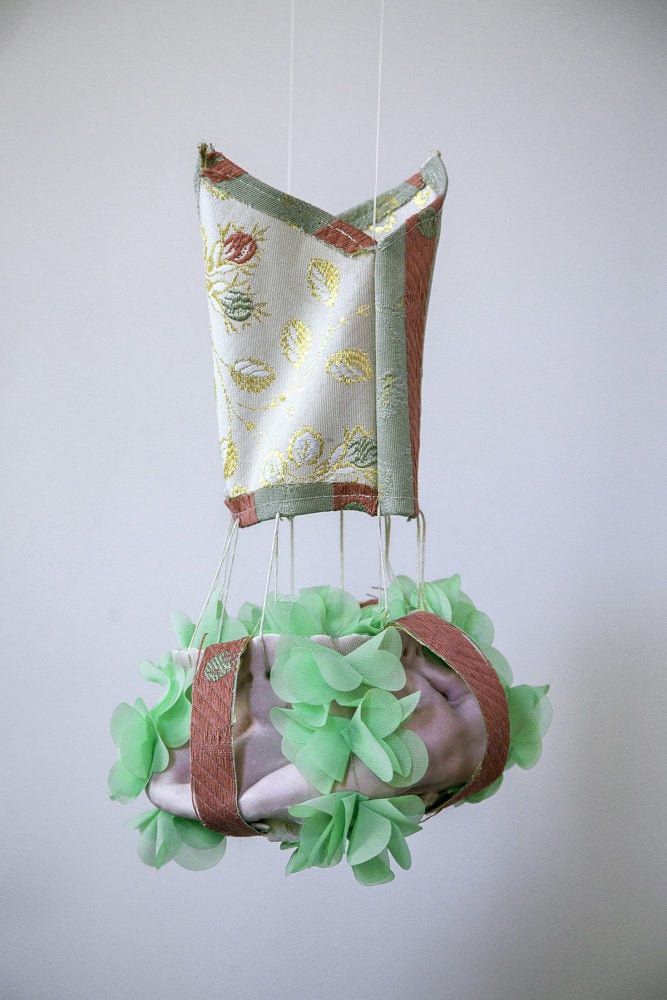
Clare Samani in Louisiana Contemporary
Clare Samani’s works at the Ogden Museum of Southern Art give the impression of gifts parachuting down from the sky into your hands. Suspended from fishing line, the two sculptures are made out of clay and found textiles, and these very tactile materials, paired with the works’ small sizes and delicate display, add to the impression of intimacy they impart.
In Riveted, a pink glazed clay vessel is wrapped like a present in mint-colored synthetic flowers and orange bands of fabric. Here, Samani’s idiosyncratic explorations of form and texture suggest an offering at an altar and, in the precise construction of the fabric components, evidence of the artist’s hand.
The careful stitching and gathering in Slick, also on view at the Ogden, appears like a snake skin or a delicate creature floating underwater. The contrast between the sculpture’s organic shape and synthetic materials shows what Samani does best—reminding viewers that it’s possible to reimagine scraps into something entirely new.
— Charlie Tatum
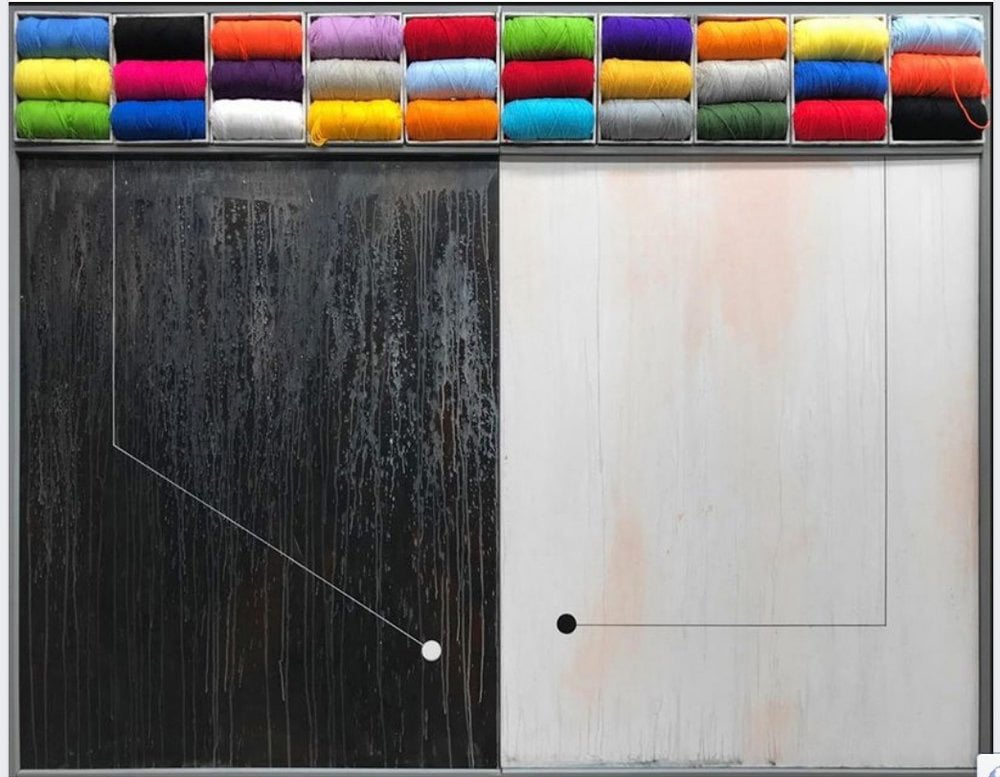
Luis Cruz Azaceta in Identity Measures
When Portuguese ships sailed down the West African coast in the middle of the fifteenth century, their decision to identify human beings as a more valuable commodity than gold and spices would become humanity’s most heinous crime. Arguably more destructive to our coexistence than the actual oppression and mutilation of African and indigenous peoples were Europeans’ attempts to rationalize these acts, which led to the creation of race—a concept that has historically made skin complexion a barometer for the treatment of others. This social condition is particularly prominent within cultures that contain descendants of the African Diaspora, which, excluding about half of Antarctica, includes the entire Western Hemisphere. A prime example of this affliction occurred in 1899 when two anthropologists exhumed the body of the Cuban independence army’s second-in-command general, Antonio Maceo, in an attempt to disprove his African heritage. In Measure of Equality, Cuban artist Luis Cruz Azaceta places spools of thirty different colors of yarn above a bisected black and white canvas, creating an abstract framework for unpacking issues of identity, racial categorization, and racist bigotry.
— Nic Aziz

Thomas Deaton in Louisiana Contemporary
Artist Thomas Deaton’s painted cityscapes depict uncanny versions of New Orleans. The air is thick and purple. Usually cheery yellow buildings are tinged with radioactive hues. The city feels vacant and post-apocalyptic, with only a few lone figures wandering around.
Deaton’s training as a printmaker is evident in the three works on view in Louisiana Contemporary. In Garden, Probably, Deaton overlaid the crisply outlined brickwork of a large structure with feathery sprigs of grass, creating the illusion of a ghostly reflection behind the rows of plants. In another work, the bright rectangular lights of a building in the distance are echoed across a spooky, overgrown baseball field. By leaving much of the undermost layers visible and using expressive, non-realistic colors, Deaton creates otherworldly scenes that seem to defy the logic of space.
In Dean’s Gun Range, a lone man stands at the bottom of a nearly empty pool, using its pink sides for target practice. Beyond a surrounding fence, windows are dark and the green brush is thick. Deaton’s paintings are somehow omens, warnings for a city that has already felt the horrors of environmental disaster and will continue to be a battleground for our climate crisis.
— Charlie Tatum
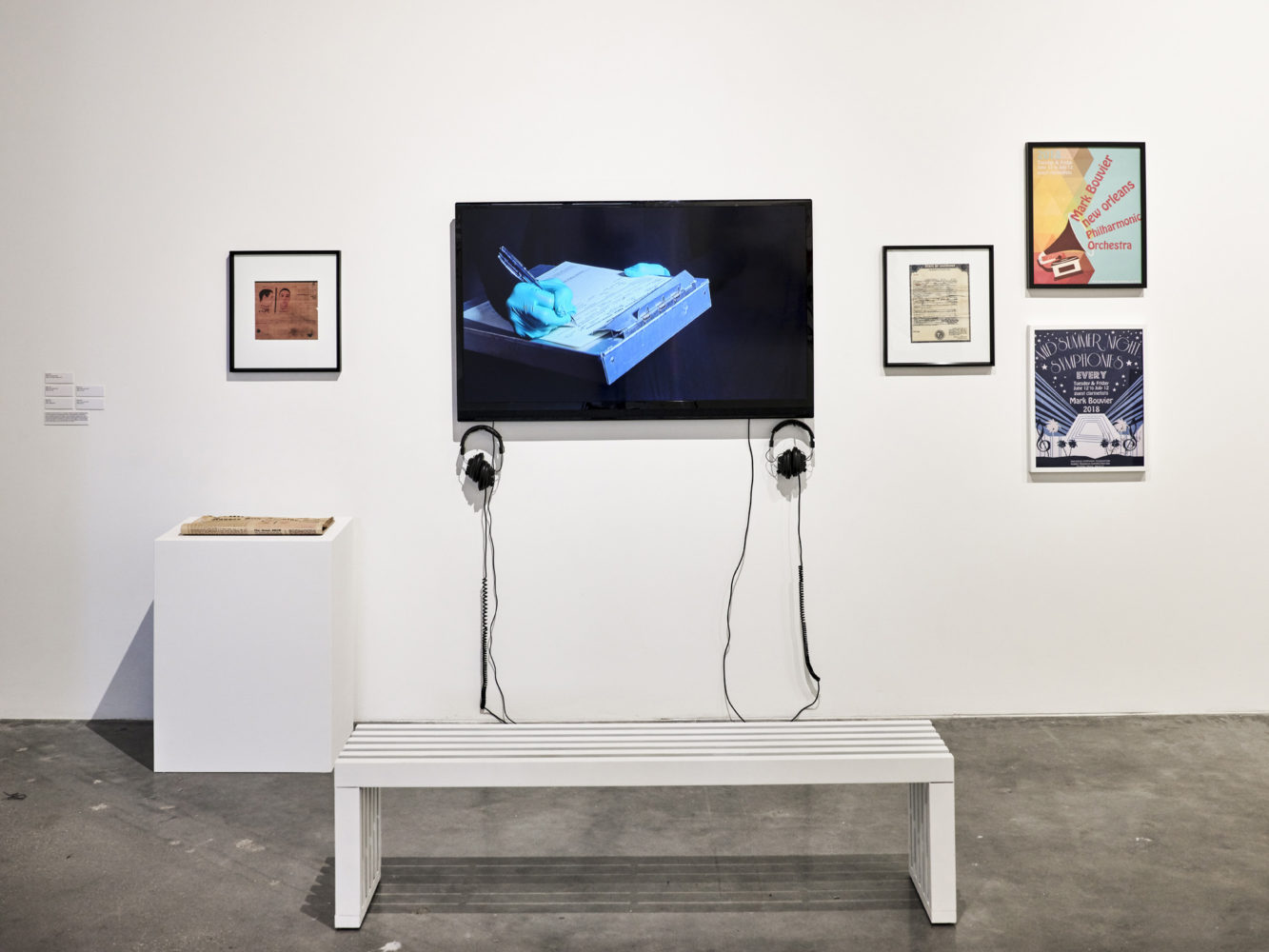
Sarah Hill in Identity Measures
Sarah Hill’s multimedia installation Mark is an investigation into the life of a fictional trans man, Mark Bouvier, who the artist imagines as a classically trained musician born in 1920. Here, Mark exists through a series of historical documents, concert posters, and a video documentary that attempts to simultaneously uncover clues as to who Mark was and expose the ways he was erased from history, providing an acute reminder of the countless other trans people who have been forgotten or who never were invited to openly exist as themselves at all.
— Taylor Murrow

Jessica Strahan in Louisiana Contemporary
Recent research suggests that trauma experienced by individuals can have major genetic impacts over time. This research is being led by Dr. Rachel Yehuda, professor of psychiatry at Icahn School of Medicine at Mount Sinai, who has revealed that historic incidents of severe collective trauma, such as slavery and the Holocaust, can change alter genetic material in specific ways and that, in turn, these genes can be passed down to future generations. Based on these conclusions, sociologist Dr. Joy DeGruy has coined the term “Post-Traumatic Slave Disorder,” a play on the widely known psychological condition Post-Traumatic Stress Disorder (PTSD). As African Americans and other people of color continue to make petitions for the value of their lives, you wonder if a country that became the wealthiest in the world through the literal devaluation of these people can ever truly fulfill its obligations to them as citizens or repair the immense damage that has been done. In Survived, Jessica Strahan presents us with a side-profile portrait of a Black figure whose expression conveys both fortitude and exhaustion—and perhaps even incredulity, with her mouth slightly agape. Rendered in oil and acrylic paint on handmade paper, the lustrous blue hues underlying swathes of brown and black play with the visual perception of dark skin tones and possibly reference enslaved Africans’ complex relationship with indigo.
— Nic Aziz

Cristina Molina in Identity Measures
Cristina Molina’s photographs Matrilineal Portrait and Patrilineal Portrait depict generations of women from both sides of the artist’s family. Dressed in identical fabric and linked together by touching or fiercely grasping hands, the women appear as unified units, strong and steadfast in their familial bond. Set against the luscious background of tropical South Florida, the photographs draw connections between home and history, while a third photograph, Birds of Paradise, suggests connections between women and the natural world.
— Taylor Murrow
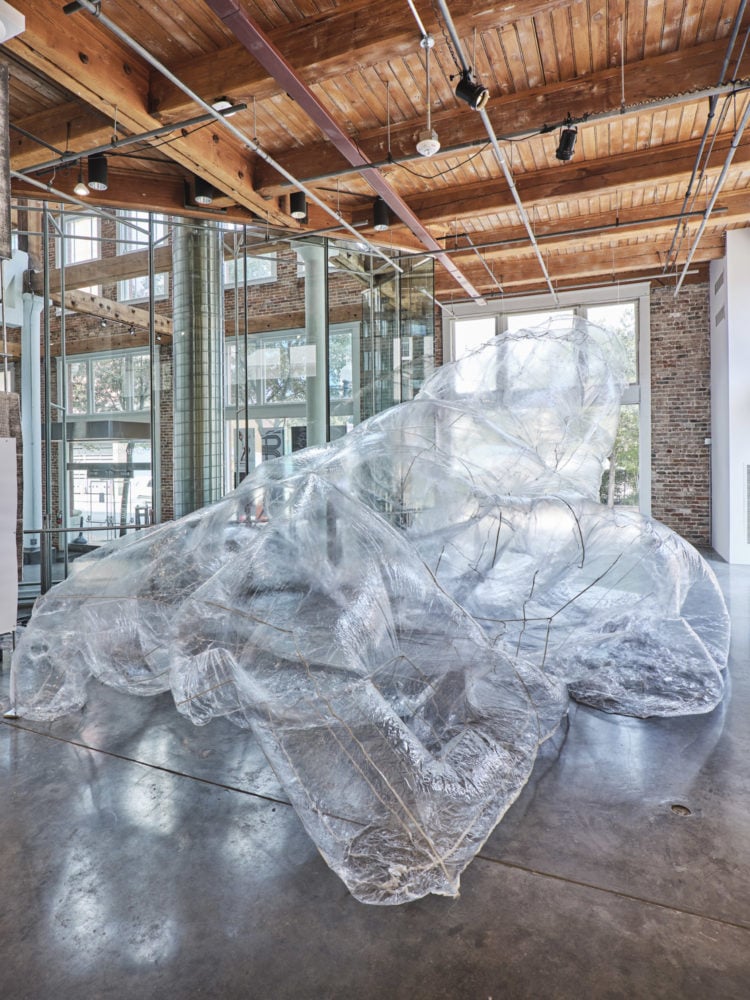
Cora Lautze in Identity Measures
Several perplexing sounds greet you as you enter the galleries containing Identity Measures at the CAC, including audio from a video installed further into the exhibition. Another prominent sound is the result of the intermittent action of a mechanical pump injecting air into a transparent inflatable sculpture by artist Cora Lautze. Standing around eleven feet tall, The Wonderful Barn is a hand-sewn reproduction of a folly, a whimsical structure built for decorative purposes and historically associated with eighteenth-century English and French landscape gardening. Perhaps even more fascinating than the history of the original Wonderful Barn in Celbridge, Ireland, is the metaphorical significance of Lautze’s reproduction. According to CAC chief curator Andrea Andersson, gallery attendants have been advised to be extra vigilant with The Wonderful Barn due to the work’s fragility and size. Because of the material’s tendency to tear, requiring almost daily repair from staff, Lautze’s sculpture creates new meaning and possibility for the term community art while additionally affirming the adage “it takes a village.”
— Nic Aziz
Identity Measures remains on view at the Contemporary Arts Center, New Orleans, through October 3.
Louisiana Contemporary remains on view at the Ogden Museum of Southern Art through January 5, 2020.

